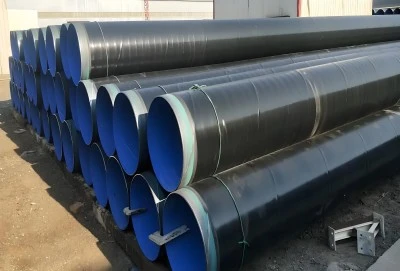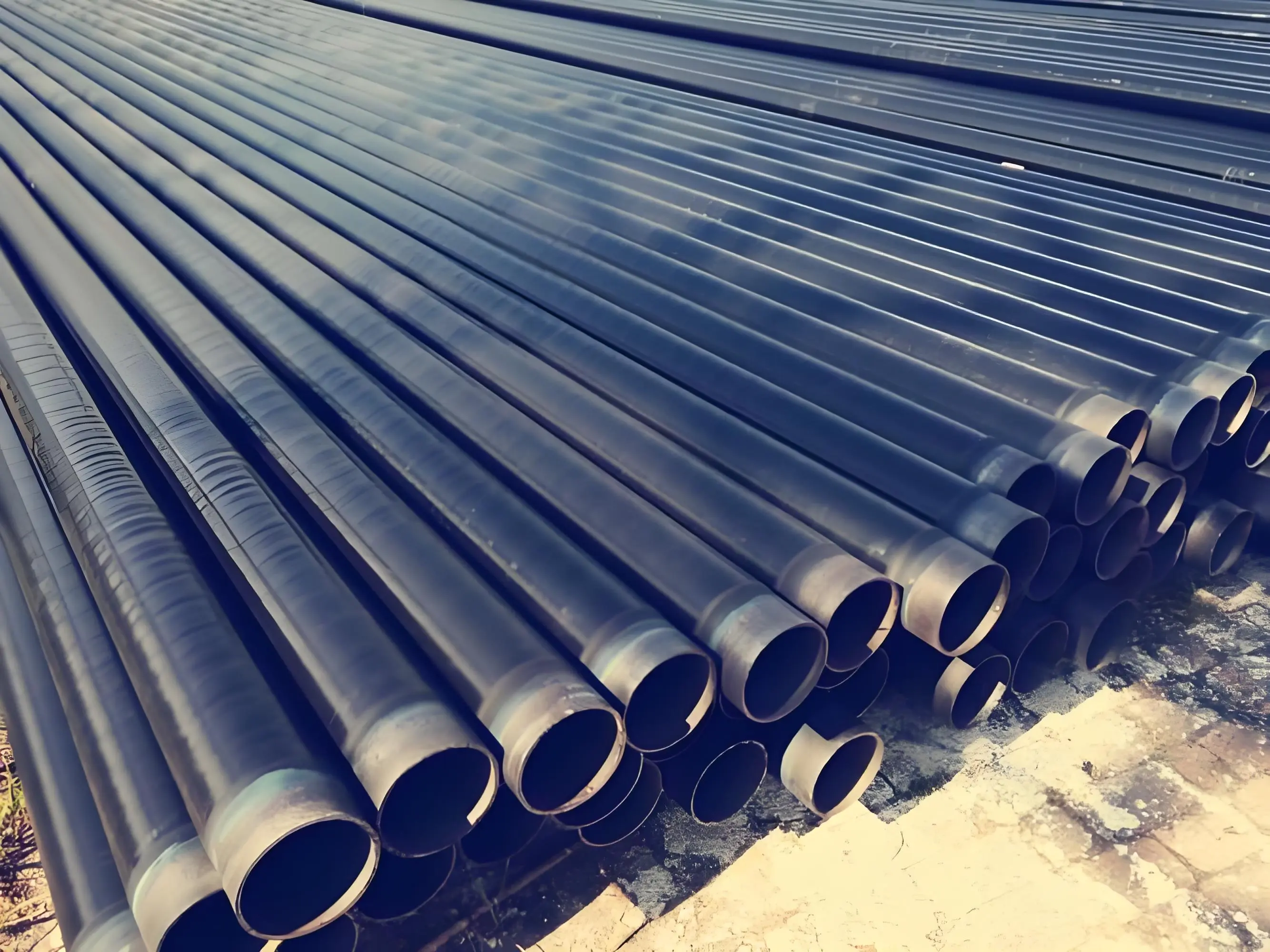Fusion Bonded Epoxy (FBE)
Fusion Bonded Epoxy (FBE) is a widely used coating type for steel pipes, particularly in the oil and gas industry. 3PE coating pipe is applied as a dry powder to a preheated pipe surface, where it melts and flows to form a continuous protective layer. The name "fusion bonded" refers to the process by which the epoxy chemically bonds with the steel substrate, creating a strong and durable coating.
The application process for FBE coatings involves several steps. First, the steel pipe surface is thoroughly cleaned and prepared, typically through abrasive blasting to remove any contaminants and create a roughened surface profile. The pipe is then heated to a temperature above the melting point of the epoxy powder, usually around 200°C (392°F). The electrically charged epoxy powder is sprayed onto the hot pipe surface, where it immediately melts and flows to form a uniform coating. As the pipe cools, the epoxy cures and hardens, forming a chemically resistant barrier.
FBE coatings offer excellent corrosion protection and chemical resistance. They are particularly effective at preventing corrosion under insulation (CUI), a common problem in industrial settings. The thin film nature of FBE coatings (typically 300-600 microns thick) allows for good heat transfer, making them suitable for high-temperature applications. Additionally, FBE coatings exhibit good flexibility and impact resistance, which helps maintain coating integrity during pipe handling and installation.
However, FBE coating pipes do have some limitations. They can be susceptible to damage from UV radiation if exposed to sunlight for extended periods. They also provide limited protection against mechanical damage compared to some thicker coating systems. Despite these drawbacks, FBE remains a popular choice due to its overall performance, ease of application, and cost-effectiveness for many pipeline projects.
|
|
|
Three Layer Polyethylene (3PE)
Three Layer Polyethylene (3PE) coating is an advanced pipe coating system that provides superior protection against corrosion and mechanical damage. As the name suggests, this coating consists of three distinct layers, each serving a specific purpose in the overall protection scheme.
The first layer of a 3PE coating is typically a Fusion Bonded Epoxy (FBE) primer. This thin layer (usually 50-100 microns) provides excellent adhesion to the steel surface and offers the primary corrosion protection. The second layer is an adhesive, often a modified polyethylene. This intermediate layer ensures a strong bond between the FBE primer and the outer polyethylene layer. The third and outermost layer is high-density polyethylene (HDPE) or medium-density polyethylene (MDPE), which provides mechanical protection and resistance to environmental factors.
The application process for 3PE coatings is more complex than for single-layer coatings. After the FBE layer is applied and cured, the pipe passes through extruders that apply the molten adhesive and polyethylene layers in quick succession. The entire system is then cooled under controlled conditions to ensure proper bonding and minimize residual stresses in the coating.
3PE coating pipes offer several advantages over single-layer systems. The combination of FBE and polyethylene provides excellent corrosion protection along with superior resistance to mechanical damage, soil stress, and environmental factors. The thick polyethylene outer layer (typically 2-3 mm) offers excellent protection against impacts, abrasion, and penetration. This makes 3PE coated pipes particularly suitable for trenchless installation methods like horizontal directional drilling.
Moreover, the smooth surface of the polyethylene layer reduces friction during pipeline installation and can help minimize soil stress on buried pipelines. The high electrical resistivity of polyethylene also enhances the effectiveness of cathodic protection systems. While FBE coating pipes are generally more expensive than single-layer FBE coatings, their superior protection and longer service life often make them a cost-effective choice for demanding applications, especially in harsh environments or where maintenance access is limited.
Galvanizing
Galvanizing is a well-established method of protecting steel pipes from corrosion. This process involves coating the steel surface with a layer of zinc, which acts as a sacrificial anode to protect the underlying steel. Galvanizing can be applied through hot-dip galvanizing or electroplating, with hot-dip being the more common method for steel pipes.
In the hot-dip galvanizing process, clean steel pipes are immersed in a bath of molten zinc at temperatures around 450°C (842°F). The zinc reacts with the iron in the steel to form a series of zinc-iron alloy layers, with a layer of pure zinc on the outside. This metallurgical bond between the zinc and steel provides excellent adhesion and durability.
Galvanized coatings offer several advantages. The zinc layer provides both barrier and sacrificial protection against corrosion. Even if the coating is scratched or damaged, exposing the steel, the surrounding zinc will corrode preferentially, protecting the exposed steel. This self-healing property is a unique advantage of galvanized coatings. Galvanizing also provides good abrasion resistance and can withstand rough handling during transportation and installation.
However, galvanized coatings do have limitations. They are not suitable for highly acidic or alkaline environments, as these can rapidly degrade the zinc layer. The thickness of galvanized coatings is also limited, typically ranging from 50 to 200 microns, which may not provide sufficient long-term protection in very aggressive environments. Additionally, galvanized coatings may not be suitable for pipes that will be subjected to high temperatures in service, as the zinc can become brittle and potentially flake off at elevated temperatures.
Despite these limitations, galvanizing remains a popular and cost-effective coating option for many steel pipe applications, particularly in less aggressive environments or where periodic maintenance and recoating are feasible.
3PE Coating Steel Pipe For Sale
LONGMA GROUP is a reputable manufacturer and supplier specializing in high-quality coated steel pipes. They offer two primary coating options: 3PE (Three Layer Polyethylene) coating and FBE (Fusion Bonded Epoxy) coating. These coating types cater to a wide range of applications in various industries, providing excellent corrosion protection and mechanical resistance.
For customers interested in 3PE coating steel pipes, LONGMA GROUP offers an impressive turnaround time. They can deliver standard specifications in as little as 7 days, which is particularly beneficial for projects with tight schedules or urgent requirements. This rapid delivery capability, combined with their expertise in pipe coating technologies, makes LONGMA GROUP a reliable partner for pipeline projects.
If you're in the market for 3PE coating pipes or need guidance on selecting the most appropriate coating for your specific project needs, you can reach out to LONGMA GROUP directly at info@longma-group.com. Their team of experts can provide detailed information about their products, assist with technical specifications, and help ensure you choose the optimal solution for your pipeline project. Whether you're working on an oil and gas pipeline, water distribution system, or any other application requiring protected steel pipes, LONGMA GROUP's range of coating options and quick delivery times can help meet your project requirements efficiently.














